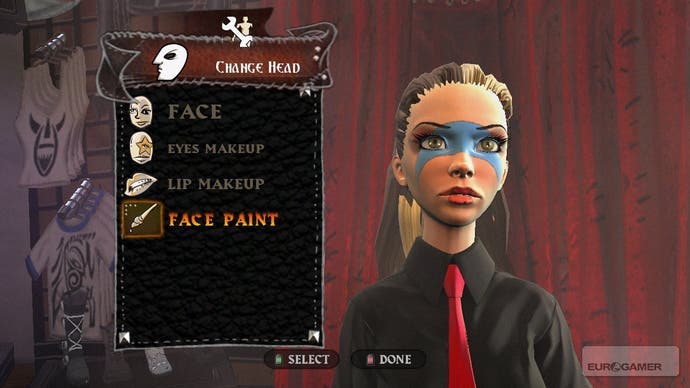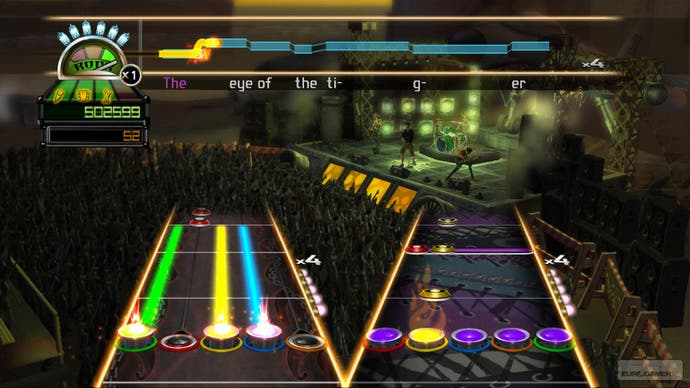Guitar Hero World Tour
Fret management.
Master recordings may be the norm these days, but there's still a sense that Guitar Hero World Tour is an "As made famous by..." The Rock Band series is now two games and many dozens of downloadable songs deep, and developer Harmonix, having abandoned the Guitar Hero series it designed and launched to work on Rock Band with MTV, was the first to present this formula - two Guitar Hero-style inputs, drums and vocals - to the public.
But when Harmonix went off to work with MTV, it left more than the interface behind. RedOctane, now part of Activision, has always made the best Guitar Hero peripherals, and after widely publicised problems with the first run of Rock Band instruments, RedOctane and Guitar Hero World Tour's developer Neversoft hope that the game's alternative range will provide sufficient ammunition to reassert Guitar Hero's lead in the battle of the band game brands.
To begin with, the new wireless guitar peripheral introduces a slider bar halfway down the neck, which performs a similar function to the Rock Band guitar's solo buttons, allowing players to tap without strumming for certain note sequences. It's touch-sensitive though, so tapping is unnecessary. As the name suggests, you just slide, and once it clicks it's the most intuitive and satisfying attempt to expand on the Guitar Hero tradition yet. Those with older guitars can tap the fret buttons without strumming for the same effect, which is only mildly less engaging.

Like Guitar Hero III's excellent Les Paul, the new guitar also strums with a click, but there's a bit more resistance - a better implementation of the same approach taken with Rock Band's soft strum bar - while the whammy bar is longer for easier use, and a Star Power button gives players the option of palming for score multipliers rather than whipping the neck aloft. There are also new multi-part extended sustains, where you strum additional notes while keeping hold of others, building up chords. Rock Band's Bass Groove - a proper 'zone' feature for bassists - is an inevitable and much-missed absentee, but a purple horizontal line invites bassists to lay off the frets and play an open note to add a bit of variety.
As with Rock Band 12 months ago - or about five minutes ago in Europe - the drums are the most interesting element of Guitar Hero World Tour because they're the biggest novelty, and RedOctane has also outdone the Rock Band kit here with a five-pad set that includes two raised cymbal pads and a foot pedal made out of sterner stuff than its plywood counterpart. The rubberised, velocity-sensitive drums are more fun to play with and going back to the Rock Band ones afterwards is like being given a bicycle after a car. There's even a MIDI input at the back for add-ons.
In gameplay terms, it's a similar system to the guitars: the note charts show five lanes of descending symbols and as they cross the threshold at the bottom of the screen you strike the corresponding drum. When a horizontal line approaches, it's time to hit the pedal, and accented notes provide more points for hitting the pads harder. Having presumably been called before teacher, Neversoft includes support for the Rock Band drums, which lose one lane of input from the note charts to allow for fewer pads.

For vocalists, the USB microphone is wired, unlike the guitar or drum-set, and like every karaoke game ever you're supposed to match pitch and rhythm, allowing those with a limited vocal range to sing their way through tough songs in relative comfort. You can also choose between scrolling and static lyric sheets. Scrolling follows the pitch and timing for better singing, while static gives you longer to take in the words. The difficulty levels are as forgiving as they are in Rock Band, but you still wouldn't want to venture into a "Hard" rendition without a sense of the pitch, which remains more useful than actually knowing the words.
Playing together is much the same as Rock Band, with a crowded screen showing note charts for guitar, bass and drums in the middle while vocals scroll along the top. Able to reuse the Guitar Hero interface rather than having to build a legally new one, as Harmonix had to do, players respond to familiar bright, round icons on the note charts while the traditional needle pointer for band performance quality sits in the corner, also keeping track of accumulated Star Power. Icons denoting individual multipliers sit next to each note chart for easy reference at a glance.
Star Power, collected as ever by completing highlighted note sequences without error, can be activated by individuals, but multiple players can draw upon it at once. You could argue that this doesn't engender band unity the way Rock Band's everyone-at-the-same-time Overdrive move does, but you could argue back that the experience is shared enough by physical proximity. If the group plays well in unison, the game rewards the band note-streak, while good players are able to carry poor ones. That said, failed players can't be rescued as they can in Rock Band, leading to more incomplete songs.











